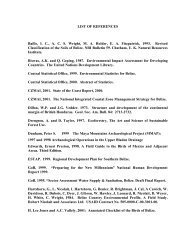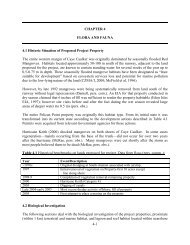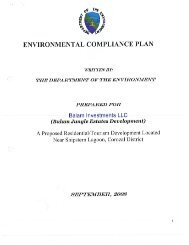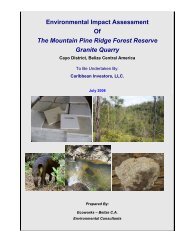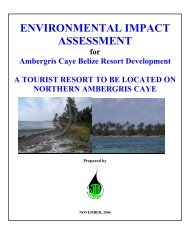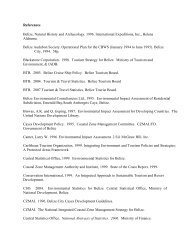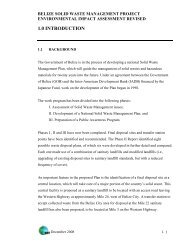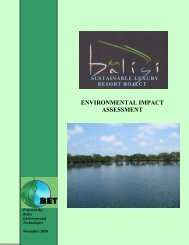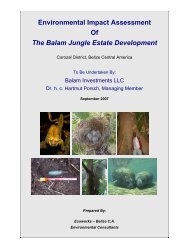Project Environment - Department of Environment
Project Environment - Department of Environment
Project Environment - Department of Environment
Create successful ePaper yourself
Turn your PDF publications into a flip-book with our unique Google optimized e-Paper software.
2.2.4 Seismology<br />
The project is not located along any major fault line or zone. The site is located northwest <strong>of</strong> an<br />
unnamed Fault line that runs parallel to the eastern coast <strong>of</strong> the caye and Barrier Reef. This fault<br />
line extends southwards from north Ambergris Caye all the way to Hicks Cayes and also parallel<br />
to the reef. There have been no known epicenters around the project site (See Fig. 2.3).<br />
For Belize, earthquake hazard increases steadily from the north <strong>of</strong> the country to the south as can<br />
be observed in the Maximum Seismic Intensity in Belize (Fig. 2.4). Earthquakes that affect the<br />
country <strong>of</strong> Belize occur in the Gulf <strong>of</strong> Honduras which is the plate boundary zone between North<br />
America and the Caribbean. Belize, on occasion, would experience mild tremors as a result. The<br />
US Geological Survey’s National Earthquake Information Center (NEIC) is responsible for the<br />
tracking <strong>of</strong> all these epicenters and according to the NEIC, Belize would experience a 6.0<br />
magnitude on the Richter scale subterranean earthquake in the ocean approximately every 8<br />
years in the aforementioned fault between Hunting Caye and Puerto Cortez.<br />
The geological faults near the <strong>Project</strong> Site along with the nearby epicenters <strong>of</strong> recent earthquakes<br />
are presented in the Geological Fault Location Map (See Fig. 2.3). With this said, the project is<br />
prone to seismic activity.<br />
It is necessary therefore that the building be designed and constructed in accordance with the<br />
Caribbean Uniform Building Code (CUBIC) or in accordance with any other Code or Standard<br />
approved by the Government <strong>of</strong> Belize.<br />
2.3 Marine Description<br />
The proposed development consists <strong>of</strong> various underwater components that make up the natural<br />
marine environment. These components are important in maintaining the stability <strong>of</strong> the marine<br />
environment and are more susceptible to minor changes as opposed to land alterations. The<br />
following is a brief summary <strong>of</strong> those components.<br />
2.3.1 Oceanography<br />
The area is most heavily influenced by both marine oceanographic process and land derived<br />
influences. This was most aptly demonstrated by the high salinities <strong>of</strong> the area which ranges<br />
from 30-36 ppt that were obtained during the surface water quality testing. Although the field<br />
sampling events was by its nature brief in duration, the floral and faunistic components <strong>of</strong> the<br />
area confirmed the high saline influences <strong>of</strong> the area.<br />
Caye Caulker and in particular the project site is surrounded by the only single body <strong>of</strong> water<br />
which is the Caribbean Sea. More aptly, the caye is located in the coral reef lagoonal system<br />
which is located behind the Mesoamerican Barrier Reef System that has been designated as a<br />
World Heritage Site. Other oceanographic components critical to the stability <strong>of</strong> the underwater<br />
or marine environment involves the movements <strong>of</strong> currents as well as wind and waves.<br />
2-6




